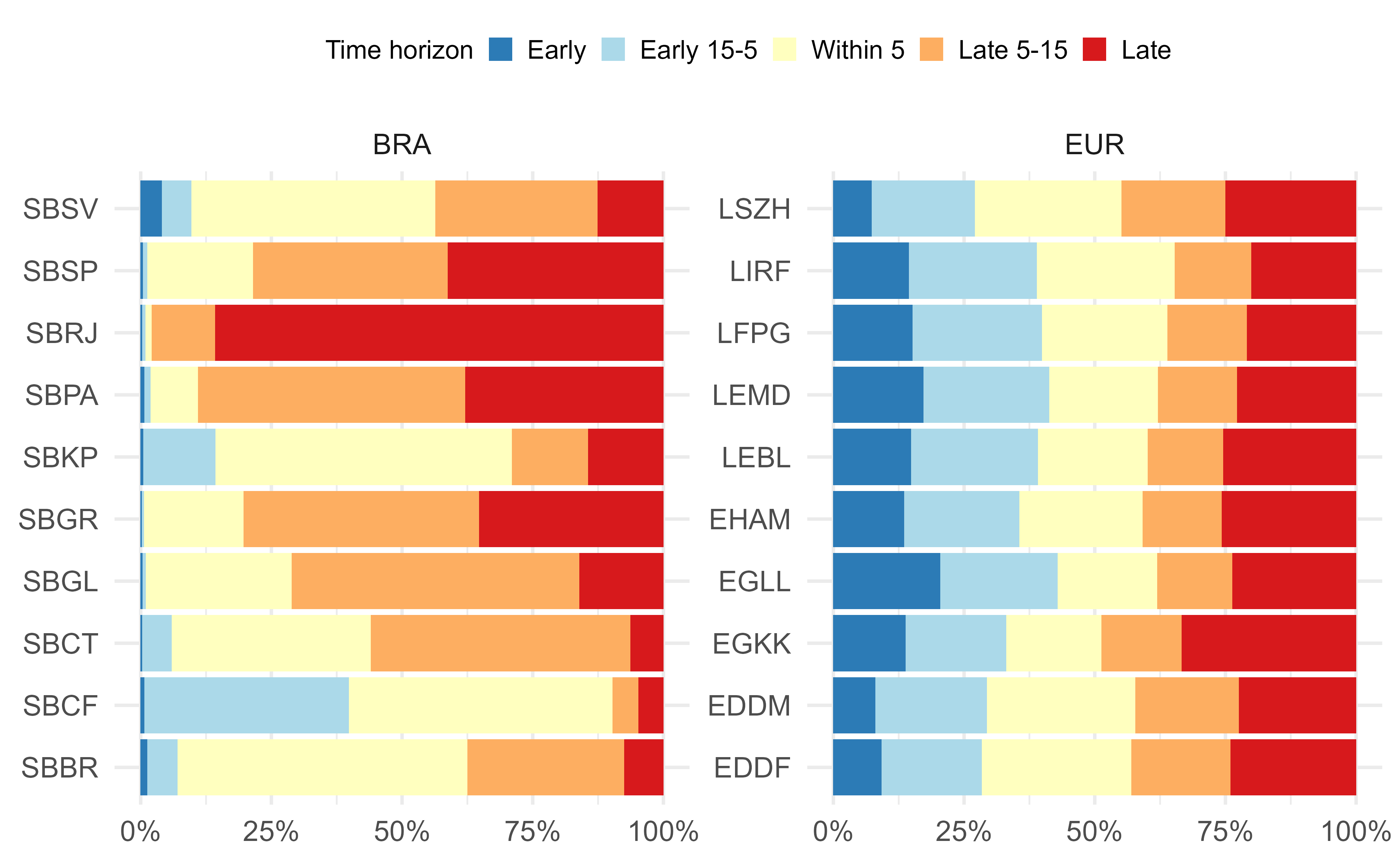Chapter 4 Predictability
Predictability in the system affects operations in both the strategic phase when airline schedules are produced and in the operating phase when ANSPs and stakeholders are balancing demand and capacity. High levels of predictability will benefit ANSPs servicing airspace users with a view to achieving highly efficient operations also during peak periods. This report focusses on the arrival and departure punctuality as measures of predictability.
4.1 Arrival Punctuality

Figure 4.1: Arrival punctuality across study airports in 2019
Arrival punctuality in Europe in 2019 was characterised by a relatively homogenous variation across the study airports, c.f. Figure 4.1. A share of 60-70% of the flights arrived within 5 minutes (or earlier) of their scheduled time. This behaviour was driven by the slot coordination and associated schedule. Due to the high level of ATFM delay observed across Europe in (2018 and) 2019, around 20% to 25% of the flights arrived later than 15 minutes after schedule. The data also shows a significant share of flights arriving early. In particular, across the European airports about 20-25% of flights arrive earlier than 15 min. This observation gained higher attention over the past years as operations at airports nearing the congestion/capacity level were impacted by the earlier demand. Airspace users may have reacted to constraints at congested airports by increasing their scheduled block times.
For the Brazilian context, this analysis is an initial attempt. The dataset for this particular comparison might contain additional variances as it is based on an estimation and manual data collection process by the operators. Santos Dumont(SBRJ) is an example worth of further research in future editions. Work is underway to enhance the accuracy of the respective information. For the Brazilian airports, there is a negligible share of flights arriving early, i.e. 15 or more minutes earlier than scheduled, while conversely a significant share of flights arrive late 5 minutes or more. Nevertheless, across the Brazilian airports, the share of flights arriving within 5 minutes of their scheduled arrival time was on average higher than in Europe. For a good share of aerodrome operations, the traffic situation in Brazil showed a higher level of arrival predictability. Congonhas (SBSP), Guarulhos (SBGR), and Galeão (SBGL) showed a spread of arrivals within 5 minutes of their schedule. This result matches the spread of arrival punctuality values at European airports.
4.2 Departure Punctuality

Figure 4.2: Departure punctuality across study airports in 2019
On average, the share of departures within 5 minutes of their scheduled time in Brazil ranged at or above the departure punctuality values observed in Europe.
Salvador (SBSV) experienced the highest share of early flights. Around 55% of flights depart 5 or more minutes before schedule. This behaviour may be the result of the manual data collection process resulting in differences between the scheduled and registered actual take-off times. In addition, a high share of late departures was observed at Galeão (SBGL). However, a good share of 70% to 75% of Brazilian traffic departed within 5 minutes or earlier than scheduled. As highlighted above for the observed arrival punctuality performance, future research might focus on further investigation on the all-causes delays behind the 20% to 25% share of late departures.
The interplay between the slot control process and departure schedules can be observed at European airports. About 60-70% of flights departed within 15 minutes of their schedule and with a robust share of 35-40% even within 5 minutes. Very early departures are the exception. Particularly in 2019, Europe witnessed a significant share of ATFM delay. The surge of ATFM delay in 2019 contributed to the observed delays in departures across the study airports.